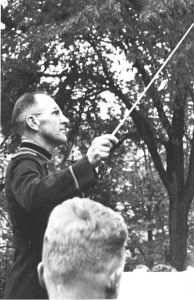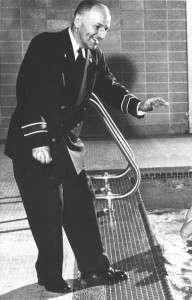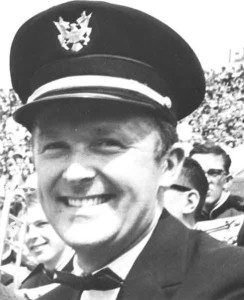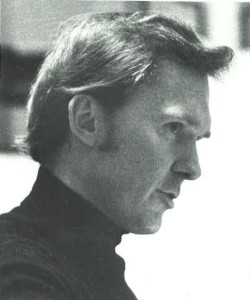
Director of Bands
1934-68
Morphy passed away in May 1934. That fall, an assistant band director from the University of Illinois was hired to lead the Wisconsin Band program. His name was Raymond Francis Dvorak. For the next third of a century, not only was the Wisconsin band program led to new heights of accomplishment and exceptional recognition, but also the university, the city of Madison, the state and even the nation were to feel the vibrations of this band director, teacher, composer/arranger, author, song leader, humorist, and humanitarian.
Under Ray Dvorak, the bands, both marching and concert, paid tributes to national heroes, university dignitaries, sports figures, and always found the proper music to celebrate significant historical events. These include celebrations of the 50th and 75th anniversaries of the Wisconsin Band program in 1935 and 1960.
The last half of the 1930’s saw the establishment of the marching band. Under the direction of Ray Dvorak, the marching band became nationally renowned for the many innovations brought to the halftime presentation. According to the University of Wisconsin News Service, “Professor Raymond R. Dvorak has developed many ‘firsts’ in the field of band pageantry at athletic contests, especially football games. He developed the singing band, mass singing, formations without signals, and animated formations. He originated the airplane band formation with sound effects; the formation of the score of the game immediately after the game; flank and oblique movements in formations; and the singing of ‘salute’ songs to the competitors.”

The singing of Varsity and the accompanying hand wave became a very special Wisconsin tradition. It has been sung in full voice by millions of Wisconsinites, not only at football games and other sporting events, but also at concerts, commencements, banquets, and many other gatherings of Wisconsin faithful.
During the 1940-41 band, there was a sophomore by the name of Gordon Haldiman. When he auditioned in 1939, Haldiman could not have envisioned how his life, Dvorak, or others in the band would be affected. According to Dvorak, “A young man named Gordon Haldiman came to see me and wanted to play in the band. He was blind. I said, ‘What can I do with a blind man?’ I asked him how he could read music, and he showed me, by braille. I took him on as an experiment. By the end of the first year he was ready to try marching in the band. He marched in the center of one of the ranks and the boys on each side would give him directions. In 1940, we went to New York and he marched down Broadway with us. That was one of the greatest joys of my life. For the next three years he was my trombone soloist in the concert band.”

Since the band tradition stemmed from a military background, it is not surprising that the name of a female does not appear on the regular band roster until the fall of 1939. Margaret Rupp appeared as a harpist in 1932 and continued to perform in the music program or provide students for the program over the next 45 years. There had existed a “Women’s Symphonic Band” on campus since 1933 though it disbanded in 1939. Many young women participated in high school band programs throughout the country, yet there appeared to be no place for women instrumentalists in the band program at the university. This brought reaction from the women musicians, their parents, and their band directors back home. Together, they mounted a letter and phone campaign to the university administration. Dvorak responded by consenting to audition women for the fall concert band with no guarantees. As history records it, three made the concert band that year. The marching band remained a male organization until 1974 when Director Michael Leckrone also consented to audition women with no guarantees. Several were accepted that year, and women continue to be full partners in the Wisconsin Band program today.
On April 14, 1948, en route to judge the Tri-State Music Festival in Enid, Oklahoma, Dvorak was riding on the Rock Island’s “Texas Rocket.” 14 miles from its destination, the train was rammed broadside by a truck loaded with sand. Dvorak was in one of the last three train cars, which were most affected by the impact of the truck. In all, two people were killed and some 41 inured. Dvorak suffered the loss of his right arm and nearly lost his left leg. He also suffered severe burns over much of his body. This accident set in motion a chain of events affecting the lives of many. The band finished out the year under the leadership of Dvorak’s assistant, Robert Fleury. They made and sent recordings to his hospital in Oklahoma. Upon his return to the University Hospital, the band gathered to serenade him. In the summer of 1948 a great deal of uncertainty prevailed at the university in regard to Dvorak’s future.

Acting Director of Bands
1948-50
In the fall of 1948 with their bandleader hospitalized, the university hired Emmett R. Sarig to take over the reins of the famed Wisconsin Band. This highly successful and innovative high school director from Maine Township High School in Des Plaines, Illinois arrived on campus just two weeks before the fall session began and faced a football schedule with eight home games. Augmenting the well-established traditions of the Wisconsin Band, he added his own innovations to the halftime and concert performances. The marching band used two drum majors and often split into two performing groups that played for the “forgotten people” in the end zones. 1948 was Wisconsin’s Centennial year, a theme that was carried out in many of the band’s halftime performances. The Fanfare (Herald) Trumpets were featured and became an integral part of the band’s performance, both in marching and in concert.
While the Sarig marching bands continued to receive adulation from the crowds and the press, his concert bands were also making their marks and began extended statewide concert tours. Those successful tours were continued by Dvorak upon his return and remained a vital part of the program until his retirement. Due to Centennial celebrations, the band entertained many dignitaries who visited the campus, including President Harry S. Truman and India Prime Minister Pandit Nehru. The band, its spirit, its fine musical ensemble, and its great traditions flourished under Sarig. Everything was well in place upon the return of Ray Dvorak as director of bands.
Many people at the university and in the band world doubted that Dvorak would ever return to the job of directing a Big 10 band. It seems by all accounts of family and friends that such a thought never occurred to him. After two years of convalescence, rehabilitation, and learning to live with pain (which he had to do for the rest of his life), he was back on the job as Director of Bands at the University of Wisconsin. In retrospect, at the age of 50, his career was just getting started. In the fall of 1950, Dvorak returned to the podium with an artificial arm and a semi-repaired leg. Nothing else seemed to have changed and it did not take long before band members forgot about these injuries. Dvorak, more determined than ever to carry out his mission, did just that with all of the energy and efficiency he had prior to the accident. He had always been interested in the handicapped, as attested by the Haldiman story told earlier. However, he realized that after his own accident he had a greater role to play both at the state and national level.
The structure of the band program under Dvorak was the Concert Band, which he conducted, and two other bands. Known as the 1st and 2nd Regimental Bands, based on the military traditions of the times, or “Badger” and “Cardinal” bands, these were conducted by assistants to Professor Dvorak. The marching band was under Dvorak’s direction, but usually with the help of teaching assistants. Though no one ever doubted who was in charge, Dvorak gave his assistants a great deal of responsibility both musically and administratively.
The football bands became even more innovative as television became a factor. Nationally renowned sportscaster Bill Stern was quoted after a game in 1954 as saying, “This band show was the best I’ve seen in these two years of NCAA telecasts.” He proved his point by canceling two interviews between halves in order to telecast more of the band’s performance. One of the special musical moments that was not televised came during the pregame show at a Northwestern – Wisconsin game as the combined Northwestern and Wisconsin bands joined on the field for the National Anthem. Visiting conductor Glenn Cliffe Bainum of Northwestern gave the downbeat and heard to his surprise, as well as that of 400 bandsmen and thousands of spectators, that the Northwestern Band was playing it in Concert B-flat while the Wisconsin Band performed in Concert A-flat. The alert musicians in both bands, sensing the problem, promptly transposed to the other key. The Star Spangled Banner has been heard in many rare renditions, but none will likely top that one.
Wisconsin’s first Rose Bowl trip occurred in 1953. The Wisconsin Band departed Christmas morning and traveled via train to California. All night poker games, practicing in the boxcars, and the band on the Dinah Shore Show were all memories from that bowl experience, which were captured on film. “The 1953 Band Rose Bowl Trip” became an often-run movie experience for band members and their families.
In 1960, Rose Bowl fever struck again with the late-November announcement that Wisconsin received the bid. The marching band was under the co-direction of Paul Haack and Dick Wolf who were assisting Dvorak. The bowl pacts had not yet built in money for the bands, so fundraising was again in order. Coming up slightly short of the needed funds, Dvorak was given the option of leaving a few behind so the rest could go first class or taking them all with a few less frills. Of course, he chose the latter. The band again enjoyed the adulation and recognition of the California fans and press. It was a proud group of bandsmen who boarded the train from Los Angeles for the relatively relaxing return to Madison.
The 1963 Rose Bowl Band had eight survivors from the 1960 trip, giving the band rare advantage of experience and leadership. Jim Christensen directed the marching band and assisted Professor Dvorak. This Rose Bowl band enjoyed the first air transport of any Wisconsin Band. It took two DC-7’s, props, not jets, to get the band to California and one very large moving van to get the instruments and equipment there. The UCLA campus was the band’s home in California, and members enjoyed Disneyland, Pershing Square, Los Angeles tours, and the early-to-bed early-to-rise parade sequence. They took advantage of their two-trouser, Marine-type uniforms, wearing the white pants for the parade and doing a quick change to the blue with red stripe for the game. This game was memorable, even though Wisconsin lost to Southern California 42-37, and the band show was no less historic. The NBC, the ROSE, and the great sound of the Wisconsin Band gave the then-largest TV audience for a Rose Bowl a special musical and visual thrill. Meredith Wilson, of “The Music Man” fame, came down to the field and paid a great tribute to the band on the performance and on their “most in-tune” sound.
In the closing years of Dvorak’s tenure as director of bands, one could not detect in any way that he was thinking of retirement. The bands were playing more, working even harder, and entertaining large audiences. The 1968 retirement of Raymond F. Dvorak as Director of Bands was not only a tribute to Dvorak and his family, but to the program itself and most of all, to the men and women of the bands. In his retirement, Dvorak remained extremely busy in national and state associations, both in music and for the handicapped, and was responsible more than any other individual for the enshrinement of John Philip Sousa in the Hall of Fame for Great Americans. It was “The Ray Dvorak Era,” there is no other way to describe it. Beginning in the Great Depression, interrupted by two wars and a major accident to its conductor, the Wisconsin Band marched and played its way through this third of a century in every way living up to its reputation as “Wisconsin’s Pride”!
Jim Christensen was the first full-time faculty member at the university who had as his title “Assistant Director of Bands and Director of the Marching Band.” Beginning in 1961, it was his responsibility to plan, chart, arrange, and rehearse the Marching Band for all performances.
In 1968, H. Robert Reynolds was selected as the director of bands at the University of Wisconsin to fill the vacancy caused by the retirement of Dvorak. Upon his arrival at Wisconsin, Reynolds was reluctant to make any sweeping changes in the band program during his initial year. He continued to work within the basic structure that had been established by Dvorak with only a few minor alterations. The Concert Band was re-named the Symphonic Band and a new group, the Wind Ensemble, was formed using members from the Symphonic Band. This new group was dedicated to performing wind music that employed the one player to a part concept, and was usually limited to 8-25 players. The group was ultimately to become the highest level performing organization in the band department. During the 1968 football season, the marching band was conducted by John Gates, a former graduate assistant and member of the band. Jim Christensen had resigned at the end of the 1968 school year to accept the position as the director of the Disneyland Band. Gates was brought in as a one-year replacement until the search for Christensen’s successor could be completed. In view of that, Gates, for the most part, patterned his performances after the model Christensen had set.


